Ink
Waterbased Inks Explored
Waterbased inks use water as the main solvent, and may also contain co-solvents and binders which can be petroleum based. The main purpose of these solvents are to carry the pigment, and control the cure rate of the ink film on the garment. Waterbased inks are used primarily on light colors, while discharge or HSA (high solids acrylic) inks are used for darks. Discharge inks are waterbased inks which contain a ZFS activator (zinc formaldehyde sulfate) of a certain percentage. This activator discharges the dye from cotton fibers, the pigment in the ink then replaces that dye with the pigment. The binder acts to bind the pigment into the garment.
Very bright and opaque colors can be achieved with waterbased and discharge inks, this in conjunction with the limited “hand” or feel of the print, makes this ink system very popular for garments that are sold in a retail setting. With discharge systems, Pantone color matching is often problematic and inconsistent. Due to the different dyes used by garment manufacturers, it is very difficult to match pantone colors to a high degree of accuracy, not all garments discharge the same. In addition, there can be variation between lots of shirts even when using the same style from the same manufacturer at a later date. Redyed shirts from manufacturers are not uncommon, and contribute to this issue greatly. This can make it difficult to run a reprint of the same art with exact color accuracy.
Certain garment colors and brands do not discharge well, and since discharge activator only works on cotton fibers, 50/50 blends and triblends do not discharge nearly as well as 100% cotton garments. With that being said, some very interesting effects can be made when you use a discharge ink on a blended shirt. With any ink system, testing is key to achieve the desired results. If you are wanting to use discharge ink on garment colors such as blue, purple green, or any blended garment, you should anticipate a bit more time for testing.
The ink components are often lower in price when compared to plastisol ink, however the cost per print is often more, due to the testing, additional time required for mixing, and extra documentation for each ink blend. In addition, hardeners are needed to strengthen the stencil on the screen, as the inks are very hard on emulsion. Since waterbased inks use water as a solvent, they also have the ability to dry in the screen. Some printers will use lower mesh count screens for this reason, the end result is detail limitation. This is a poor trade off, since the proper use of retarding additives and thin thread mesh, high LPI halftones can be easily achieved. But only when good materials, techniques, and planning are employed.
Often it is advantageous to utilize multiple ink systems and use discharge ink in conjunction with plastisol. Printing a discharge underbase, with plastisol top colors can give you a very thin ink deposit, with a soft hand and great detail. This combination technique works especially well with process and simulated process printing on soft rungspun garments.
Every piece of artwork is unique, and requires a high level of skill to get the best result. There are advantages and disadvantages of every ink system. The more you know about each system and the substrate it is being printed on, the better you can plan your artwork and garment selection to achieve the results that you want.
Let’s Talk Plastisol Ink
Plastisol, as discussed in our blog post, ink systems overview is the most common ink used to screen print textiles in the apparel industry. It is well suited for light and dark fabrics. It’s also well suited for a multitude of fabric blends and man made materials when formulations and catalysts are matched to the material. So today, let’s talk plastisol and discuss some of the things we can do with it.
Most plastisol is comprised of a base containing a plasticizer and a PVC resin. It is thixropic in nature, meaning it thins when sheared during the printing process. Pigments are carried by the base, sometimes referred to as the vehicle, in a suspension. When cured at around 320-330F, the plasticizer and PVC resin fuse and the ink creates a mechanical bond with the fibers of the garment. This creates a vibrant, opaque, extremely durable and long lasting print when cured correctly. In many circumstances, the print will outlast the life of the garment. When the artwork is properly separated, plastisol can often be printed wet on wet, which results in high production speeds. The viscosity and opacity is readily modifiable allowing for a wide range of print possibilities. Modern plastisols flash dry quick at around 280F and have a low after tack. This allows the printing of top colors quickly; as opposed to a waterbased or discharge ink, where the water has to be dried out first. This causes hotter pallet temperatures, which negatively effect the subsequent print colors.
Polyester, and their blends, require special consideration regardless of ink system. Low bleed plastisol ink allows us to print on cotton / polyester blends, as well as cotton / poly / rayon (triblends) and 100% polyester garments. Polyester fabric has a tendency to both subliminate and outgas around the same temperature that plastisol ink cures. This poses certain challenges that must be overcome in the ink chemistry. Low bleed inks contain dye blocking agents, along with agents that lower the cure temp to reduce sublimation. These inks are more expensive due to the chemistry of the ink, but are mandatory to prevent dye migration. A classic example is the red 50/50 blend, printed with white ink which turns pink 24-48 hours after printing. This happens as the dye migrates from the polyester fibers to the ink layer. Dye blocking, low bleed inks help mitigate this risk, but are not always fool proof. For 100% polyester, especially digital camo or garments that are known to be bleed happy, we will utilize a silicone based ink.
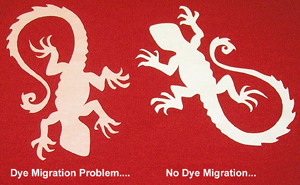
Since plastisol inks do not dye the fabric, but rather create a mechanical bond and sit on top of the garment fibers, the resulting print does have a “hand.” The “hand” is the term that we use to describe the feel of the print itself. If there is a very large print area, like a stop sign for example, the “hand” can be very noticeable. Having a large sweat patch on your garment is in no way desirable by the end user, especially when printed on a lightweight shirt. Enter the world of additives. An additive such as “soft hand base,” does exactly what the name implies. It softens the hand and in high ratios increases the translucency. Alternately, curable reducer is a thinner which reduces the thickness of the ink itself, while also reducing opacity. Ink additives, in addition to proper mesh selection and the use of highlight white screens, drastically reduce the ink deposit and the hand of the print. In the case of a simulated process print, a halftone underbase is usually used rather than a solid spot underbase, which makes for a very nice, soft hand print even with many overprint colors.
Sometimes the application calls for a different type of additives:
- Puff additive can be used to create 3D puff effects; when designed into the artwork this can be very fun, especially for kids.
- Photophosporent additive can be mixed in or printed as a stand alone ink for a glow in the dark effect.
- Nylobond allows us to print on substrates that plastisol would not ordinarily bond to, such as nylon. This is extremely useful for umbrellas, nylon bags, and windbreakers. Nylobond also lowers the cure temperature, preventing dye migration on some substrates and allowing the printing of polypropylene materials.
- Shatter base, can create a unique tattered, cracked and worn look, while still providing excellent adhesion and durability.
- Stretch additive can be used to more easily print on spandex blends.
- Suede additive can be used as either as a dulling paste for a matte finish in lower concentrations, or in higher concentrations for a suede or leather effect
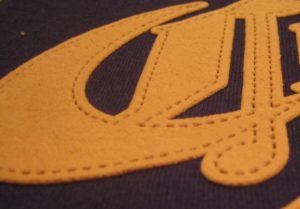
Here is a useful example of great artwork, plastisol ink, and some suede additive. With planning, the artist and screen printer were able to create a visual that mimics a leather patch.
There are dozens of other additives available that can be used to enhance any print.The availability of additives make plastisol one of the most versatile, consistent, and useful ink systems for textiles. When additives and specialty inks are thought about ahead of time and incorporated to the design, results can be stunning.
Some examples of specialty inks:
- Reflective ink, contains millions of microspheres suspended in the base, which when hit with a beam of light, reflect that light back to its source hundreds of feet away. This has been very popular with construction workers, runners, and anyone wanting to be seen at night.
- High density inks can be employed to create 3D effects, standing as much as 1/8″ off the surface of the garment. This is great for solid spot colors.
- Metallic, shimmer, and glitter inks are fairly self explanatory, and are commonly used in screen printing.
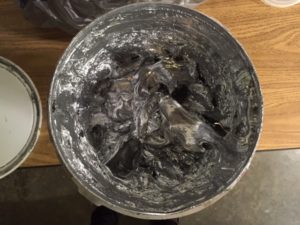
As you can see there are many benefits to using plastisol ink, and when handled and disposed of properly they are even considered to be very environmentally friendly. They emit no VOCs, and contain no evaporative solvents that pollute the air. In addition, many plastisol inks on the market are now phthalate free. Quality inks are not cheap, therefore very little is ever left on the screen. Since they never dry in the air, they can be cleaned out and reused. Any remaining residue can be cleaned up with soy based solvents, filtered, and the solids cured into a block for safe disposal. In this way, plastisol is one of the most eco friendly inks on the market.
As new garment materials and innovative blends make their way into the marketplace, plastisol will continue its evolution to meet the demand of this ever-changing industry. When used in conjunction with the proper mesh, print parameters, and variable control, plastisol is amazing. Countless award winning prints have been created with this ink system, and millions world wide use and wear it every day.
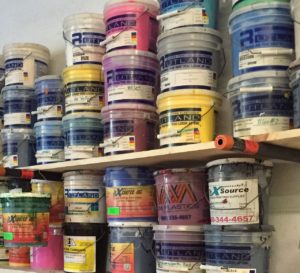
An Overview of Textile Screen Printing Inks
Screen Printing is a very versatile print process. If there is a flat surface, It can most likely be screen printed. A major consideration for any job, is the ink system to be used for a given material, or substrate. For this blog post, we will be focusing on textile applications. With the goal being an increased understanding and awareness of the abilities, applications, limitations, and economic factors that different ink systems provide.
Plastisol

Plastisol ink has been the staple ink for the garment printing industry for many years, so it makes good sense to start here. Plastisols are non water soluble and they must be heated to cure. Therefore they do not dry in the screen and are easy to work with on press. They are very opaque on dark garments, and are relatively simple to color match using pantone mixing systems. There are a wide variety of additives available which provide an enormous amount of flexibility. In addition, many special effects can be achieved using plastisol inks. Plastisol inks are well suited to a number of garment types and blends which make it a very versatile ink system. Its consistency and repeatability make it the go to ink for printers around the world. The ink components are generally more expensive than waterbased or discharge inks, but due to the printability and ease of use, plastisol is generally the most economical and cost effective ink for the majority of the apparel industry.
Waterbased and Discharge inks (HSA)
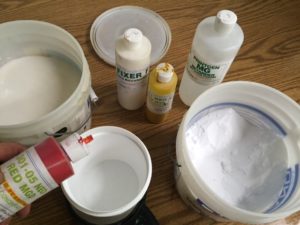
Waterbased inks have been growing in popularity recently, and for good reason. When printing waterbased inks, the ink is driven into the substrate, rather than sitting on top of the garment as with plastisol. Waterbased inks provide a very soft hand, after washing the garment will have very little to no hand. Waterbased ink is especially great for heavy nap fabrics such as towels where you want a soft surface. When cured properly, the ink will last for a very long time. Discharge inks are waterbased inks that utilize a ZFS (Zinc Formaldahyde Sulfoxylate) activator and work on 100% cotton fibers to remove the dye from cotton threads. For this reason, discharge is best used on dark 100% cotton garments. Testing is key when printing with WB and discharge inks, especially with blended garments. Waterbased inks are more difficult to mix, and while the ink components may cost less than plastisol, the time it takes to mix the ink, the requirement for hardened emulsions, and the on press characteristics of the ink make discharge a more expensive ink system in the majority of cases.
Silicone Ink
![]()
Of all of the ink systems, silicone ink is the newest. It was developed by Dow Corning in recent years to combat some of the limitations of plastisol when printing on 100% polyester garments. Polyester garments are heat sensitive, and they don’t like to hold on to their dye when heated. Sublimation and outgassing occurs near the cure temp of plastisol, which causes dye migration from the garment to the ink layer. For years low bleed plastisols have been employed often with less than optimal results. Silicone ink is quickly changing the way performance apparel is printed. Pantone colors are easily matched, dye migration is avoided, and the hand of this ink is unlike any other on the market. With more and more performance, moisture wicking, and synthetic blended materials coming onto the market, high performance ink is required. The high cost of the raw ink components do make it one of the most expensive ink systems that we use on garments. It is a catalyzed ink, so it has a limited screen life once mixed. This is one of the reasons that small batches become uneconomical to print with this system. Mid and large print runs are quite affordable when the ink cost is spread out over a larger number of garments.
The Keys to Success
Understanding the substrate, the ink systems, and a general knowledge of the print process is a must if you want to take your garments from good to great. As with anything, there are many ways to achieve the desired outcomes. The more that is understand about inks, garments, and the screen process in general, the more you are empowered to make great decisions when creating art, choosing blanks, and determining what ink is best for you needs. In future posts, we will explore each ink system in a more in depth way.

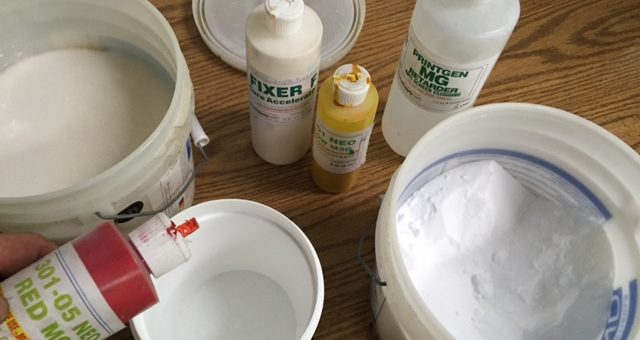
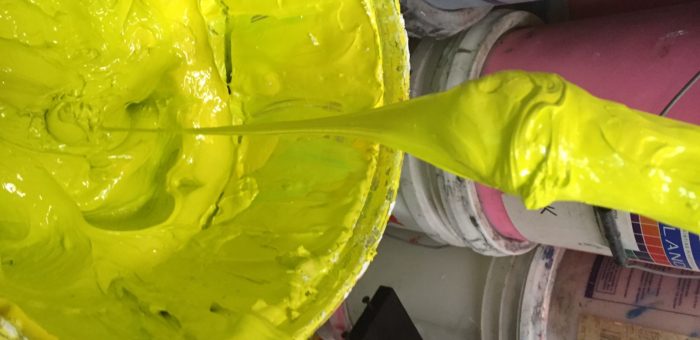
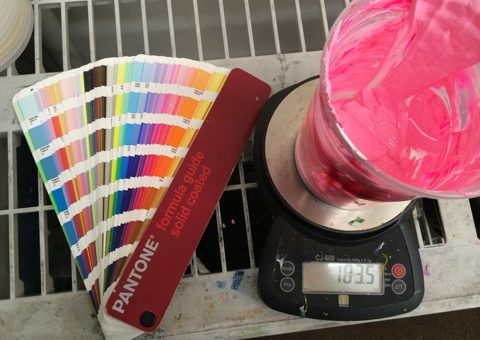
Recent Comments